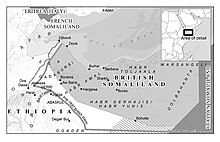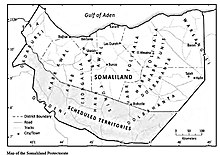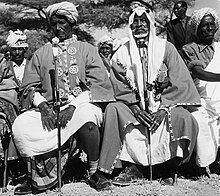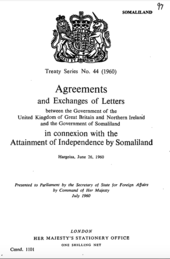British Somaliland
[12] The stated purposes of the establishment of the protectorate were to "secure a supply market, check the traffic in slaves, and to exclude the interference of foreign powers.[17] Beginning in 1899, the British were forced to expend considerable human and military capital to contain a decades-long resistance mounted by the Dervish movement.[18] The movement was led by Sayyid Mohammed Abdullah Hassan, a Somali religious leader referred to colloquially by the British as the "Mad Mullah".At Dul Madoba, his forces killed or wounded 57 members of the 110-man Constabulary unit, including the British commander, Colonel Richard Corfield.The British tricked Hassan into preparing for an official visit, then launched bombing raids in the city of Taleh where most of his troops were stationed, causing the mullah to retreat into the desert.Growth in commercial trade motivated some livestock herders to subsequently leave the pastoral economy and settle in urban areas.The few British forces that were present attempted to defend the main road to Berbera, but were dislodged from their positions and retreated after losing the Battle of Tug Argan.[28] The Somalis serving in the Somaliland Camel Corps were given the choice of evacuation or disbandment; the majority chose to remain and were allowed to retain their arms.The group also attacked the house of the district commissioner of Burao District, Major Chambers, resulting in the death of Major Chamber's police guard before escaping to Bur Dhab, a strategic mountain south-east of Burao, where Sheikh Bashir's small unit occupied a fort and took up a defensive position in anticipation of a British counterattack.The government came to a conclusion that another expedition against him would be useless; that they must build a railway, make roads and effectively occupy the whole of the protectorate, or else abandon the interior.[34] The British administration recruited Indian and South African troops, led by police general James David, to fight against Sheikh Bashir and had intelligence plans to capture him alive.The British authorities mobilized a police force, and eventually on 7 July found Sheikh Bashir and his unit in defensive positions behind their fortifications in the mountains of Bur Dhab.[36] The remaining rebels were subsequently found and arrested, and transported to the Saad-ud-Din archipelago, off the coast of Zeila in northwestern Somaliland.Full executive powers would be held by a prime minister answerable to an elected National Assembly of 123 members representing the two territories.











Italian SomalilandSomalilandSomaliGod Save the QueenGod Save the KingsultanatesBritishProtectionGovernment of IndiaBritish colonial governmentBerberaHargeisaArabicEnglishGovernorDouglas HallDervishrebellionItalian invasionBritish recaptureIndependenceEast African shillingIsaaq SultanateHabr Yunis Sultanate1941:Italian East AfricaWarsangali Sultanate1940:Italian East Africa1960:State of SomalilandSomaliade jurede factoHistory of SomalilandCaves in SomalilandLaas GaalDhambalinDhaymooleLand of PuntMacrobiansLand of the BerbersMosylonKingdom of AdalIfat SultanateIsaaq migrationsAdal SultanateEthiopian–Adal warBulharDervish movementSomaliland campaignBurao Tax RevoltSheikh Bashir RebellionState of SomalilandSomali Republic1961 revolt in SomaliaSomali Democratic RepublicSomaliland War of IndependenceIsaaq genocidePeace processDeclaration of IndependencePeace treaties of the Somaliland War of IndependenceConstitutional referendumprotectorateUnited KingdomItalian SomaliaFrench Somali CoastAbyssiniaItalian EthiopiaItaliansItalian East AfricaunitedTrust Territory of Somaliaunrecognised independent staterecognisedautonomous regionsuccessor stateMohamoud Ali ShireSultanGadabuursiHabr AwalGarhajisHabr Je'loWarsangeliMenelik's InvasionsBritish IndiaForeign OfficeColonial OfficeDervish movement (Somali)Mohammed Abdullah HassanSayyidWorld War IBattle of Dul MadobaRichard CorfieldSomaliland Camel Corpsfifth and final expeditionOdweyneBritish Armykhaki drillputteesbandolierpith helmetspuggreeCustoms taxesRed Sea4th Bombay GrenadiersEast African campaign (World War II)Italian invasion of British SomalilandEast African campaignWorld War IIBattle of Tug ArganOperation AppearanceItalian guerrilla movement1945 Sheikh Bashir rebellionSunnah prayerErigavoSheikh BashirWadamagoBurao DistrictShariaIndianSouth AfricanBadhanSaad-ud-Din archipelagoIndependence Day (State of Somaliland)Independence Day (Somalia)United Kingdom of Great Britain and Northern IrelandLondonMohamed Haji Ibrahim Egal